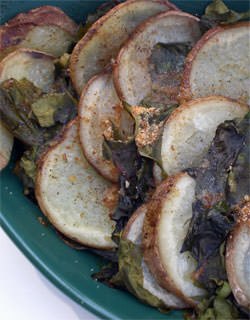

Photo by Judith Hausman
Vegetable Tian is great for using a lot of your veggies in one dish.
Right in the middle of National Eat Your Vegetables month comes Eat Your Vegetables Day on June 15—today! What will you do to celebrate? More importantly, how will we all eat the five servings of fruit and vegetables daily that we know we should? The new USDA Dinner Plate, which replaces the problematic Food Pyramid, leaves a nice big area of the plate for those veggies. And in June, there’s almost no excuse not to eat them.
Which vegetables did your parents have to push you to eat when you were growing up? When I think of the iceberg lettuce in our salads and the frozen green beans that alternated with canned peas, I’m surprised I like green things at all now. At home, I’d never eaten greens such as chard or kale. Beets, turnips, kohlrabi and celeriac never crossed the family threshold. We did have lovely tomatoes and corn and the novelty item artichokes from time to time, but the supermarkets of the time, as well as my dad’s limited palate, meant very little variety. There was a world of vegetables to discover when I started feeding myself.
I can find it a challenge that requires some thinking to eat as many servings as I should. Two-thirds of a day’s meals may be over and I’ve consumed little that counts other than a tangerine and some chopped celery in my tuna-salad sandwich. I keep 11.5-ounce cans of 100 percent vegetable juice around to help; that’s two very low-calorie servings. Vegetable soup can make a couple of servings easy, too.
Another trick is to cook lots of vegetables at once so they simply need reheating. When they are all ready, I’m more likely to grab them out of the fridge. It’s also energy-efficient to cook them at the same time as other things. For example, roast some beets and leeks while your morning muffins are baking in the oven and eat the veggies later that night.
Teach yourself a few favorite, flexible, go-to recipes. Roasting in olive oil is a terrific and fast way to cook all root vegetables, squashes and potatoes. An aglio e olio (garlic and oil) sauté is a no-fuss dish and tasty for all leafy vegetables. Here’s another recipe I use a lot: the tian, a southern-French gratin without the cream that works with any combination if you adjust the cook time and liquid a little.
Recipe: Vegetable Tian
Ingredients
- 1 medium onion, sliced 2 cloves garlic
- 2 to 3 pounds vegetables, thinly sliced*
- dried breadcrumbs
- herbes de Provence or fresh herbs, chopped
- olive oil
- salt and pepper
- stock, as needed
- 1/2 cup Parmesan or Gruyere, grated or goat cheese, optional
Preparation
Sauté the onions and garlic in olive oil until they are soft. Strew them in an oiled gratin or baking dish. On top of this layer, overlap the sliced vegetables attractively in rows. You can also intersperse leafy vegetables like chard or spinach with firmer ones like potatoes. Douse them with a bit more olive oil. A juicy vegetable like summer squash will likely not need more liquid. Drier ones, such as carrots or potatoes, may need a 1/4 inch of water, stock or wine poured gently over them.
Keep the added liquid to a minimum; the idea is to let the vegetables cook one another with their own moisture. Sprinkle on the breadcrumbs, cheese (if using) herbs and seasoning. Cover well, but uncover 10 minutes before they’re fully tender to dry out the tian a little. Bake at 375 degrees Fahrenheit for 35 to 55 minutes.
Serves 4 to 6.
*Experiment, but eggplant, zucchini, tomatoes, potatoes and fennel are more or less traditional in the south of France.




